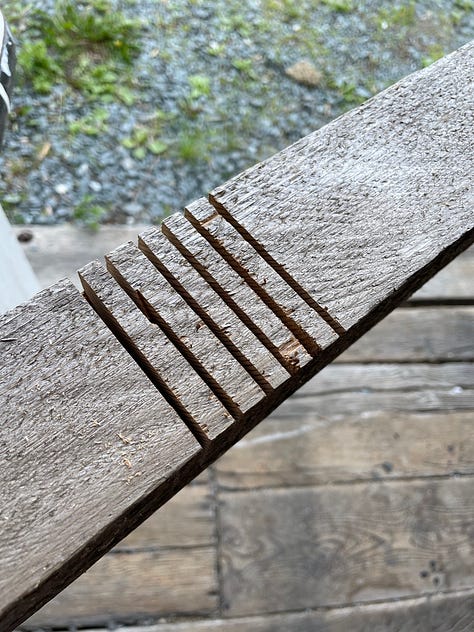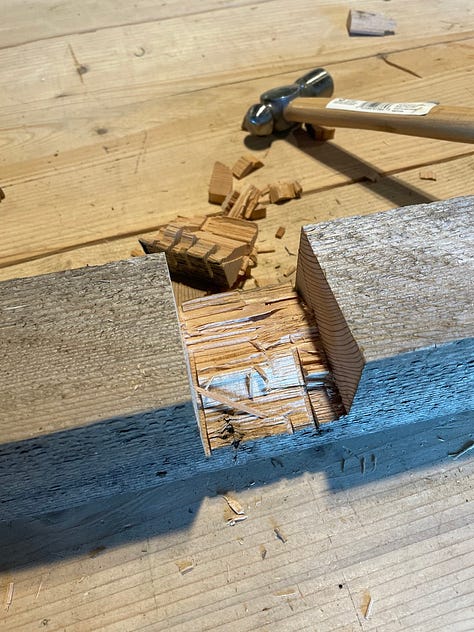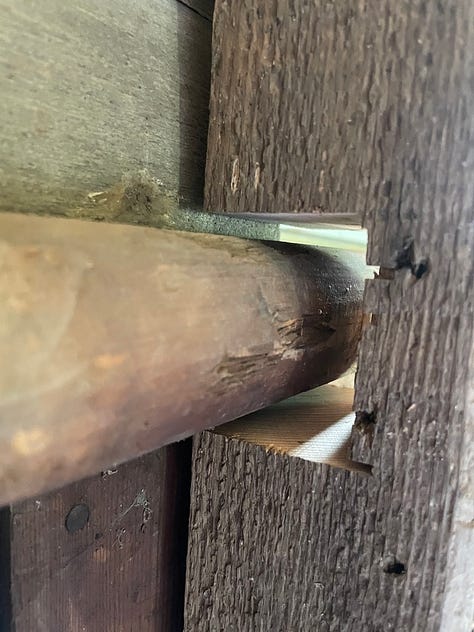My First Notch
Coffee tables, barn beams, and the art of watching and waiting
In 1968, Jean, my mom, and Sharon our neighbor plopped two crawling babies onto the shag carpet of a sunken living room in The Valley. Classic mid-century setup—floor-to-ceiling windows, sunbeams slicing through cigarette smoke, and a solid walnut coffee table that would live through decades of abuse. Including a butter yellow nail polish spill I'd cause at age seven. Still visible fifty years later.
The babies were me and Karen.
Karen was a few months younger but had outpaced me in size. I sat quietly, chewing on a toy. She wobbled her way to a semi-standing position using that coffee table as leverage. Then—crash. Down she went.
She did it again. And again. And again.
Every day for three days, Karen pulled herself up and crumbled to the ground. Determined. Relentless. Practicing in front of an audience of chain-smoking mothers who cheered every attempt.
I didn't move. Just watched.
On the fourth day, I scooted over to the coffee table, pulled myself up, and walked five full steps across the living room before lowering myself back down. No warm-up. No trial runs. No crashes.
My mom told this story like it explains everything about who I became. The kid who hung back until she was ready. Who studied the game before playing it. Who made it look effortless because all the work happened in private.
She wasn't wrong. This is still how I approach everything—from carpentry to corporate strategy.
I’ve had enough bad managers to know what not to do. I bet you have too. The ones who jumped into decisions without understanding the landscape. Who moved fast and broke people instead of things. Who confused motion with progress and urgency with strategy.
I watched them crash into the same coffee table over and over—and learned that sometimes the most valuable lesson isn't how to do it right. It's recognizing what wrong looks like before it costs you your team.
Yesterday, I needed to notch a beam for a closet I'm building in my barn. I'd been avoiding this particular cut for months—part healthy fear of power tools, part respect for the skill it requires. But I'd reached the point where it was either figure it out or abandon the project.
I'd been sneakily watching my contractor do this exact cut for months. I'd also fallen down rabbit holes learning about mortise and tenon joinery—the kind they used constructing my 1800s Dutch barn. Context. Curiosity. Enough observation to build my own private map of how to approach it.
It's the same approach I take when I'm studying a broken organizational system or watching a leadership team navigate crisis. I don't jump in with solutions. I watch the patterns. I study what fails and why. I let others test the waters while I map the terrain.
I measured twice. Set up the saw. Made the cuts. Grabbed the chisel.



First notch? Damn good.
"That's not how you do it," someone with years of experience might say. And they wouldn't be wrong. Except that is how I did it. This time. With these tools. For this project.
Maybe I'll do it differently next time. Maybe I'll learn the "proper" way according to traditional tradesmen. Maybe not.
The beam fits. The closet will hold. I learned something new without breaking anything or cutting off a finger.
That's still how I learn. How I lead. How I make decisions. Fifty-six years later.
I watch until I understand the mechanics. I study the failure points others hit. I build internal confidence before external action. And when I finally move, it looks sudden to everyone else. But it's not sudden at all.
In leadership, they call this "observational learning"—and it's vastly undervalued in our move-fast-and-break-things culture. While others are failing fast and pivoting hard, I'm the one taking notes. Watching market conditions. Studying competitor mistakes. Building strategy from other people's expensive lessons.
Sometimes those lessons come from watching excellence in action. But often? They come from watching dysfunction play out in real time. From sitting in meetings where bad decisions get made and studying exactly how they happened. From watching talented people get ground down by leaders who never learned to stop crashing into furniture.
It's the walking baby who spent three days watching her friend figure out gravity the hard way. Who waited until she had a plan that didn't involve face-planting on shag carpet.
Some people learn by doing. By failing forward. By trying until something sticks. They make great pioneers. Great experimenters. Great first movers who aren't afraid of getting bruised.
I learn by watching until I'm ready to succeed. I make calculated moves that look effortless but are built on months of quiet preparation. I'm the second mover who learned from the first mover's mistakes.
Both approaches work. Both build skill. Both get you across the room—or across the market, or through the crisis, or past the problem.
The difference is just how many bruises you collect along the way. And how much you've learned from watching other people collect theirs.
In a world that worships speed and celebrates failure, there's something to be said for the slow burn of preparation. For the leader who studies the room before making the move. For the carpenter who watches a hundred cuts before making her first.
Not everyone should lead this way. But someone should.
Because while the trial-and-error crowd is busy breaking things, we're the ones quietly figuring out how to build them right the first time.



Patience is the most underrated virtue. You exemplify it well Dacia!